 |
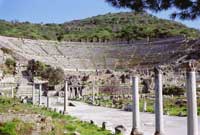 |
|
Ephesus, once the most important commercial center of the western Anatolia, is one of the highlights of Turkey that awaits the exploring tourists.
The city was established as a port on the mouth of the river Cayster and was one of the foremost cities of the world for its being on a strategic trade route in Anatolia. The city itself and the ruins are all on the sides of a fertile valley. |
|
| The extensive ruins including the theatre, library or gymnasium create the special atmosphere of Ephesus, and appeal to every visitors. Ephesus has been a "center" during the date. Once a trade center of the ancient world, a religious center of the early Christianity and today, a unique tourism center proving all its perfectas to the visitors through the world. |
|
History:
There is as yet no definite knowledge about the exact date of the foundation of Ephesus, but famous historians such as Strabon and Pausanias, agreed in the idea of that Ephesus was founded by Amazons, and inhabited by the oldest settlers of Anatolia-Lelegians and Carians, as early as 3000 BC. |
|
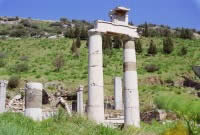 |
|
| In the year of 10 BC, Androclos, the son of King of Athens-Kodros, was searching a location for establishing a site. Androclos belonged to Akhas , was running from the Dor invasion in Greece. He was leading one of the migration convoys. It was predicted by an Apollon oracle that a fish and a boar would show the location of the new settlement. |
|
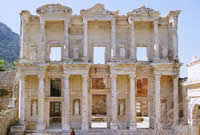 |
|
Days later, parallel to the oracle's prediction, while frying, a fish fell down from the pan, irritating a hiding boar behind the bushes. The feared boar escaped immediately. Androclos followed the boar and established the city of Ephesus, where he had killed the boar. When Androclos died in the wars with Carians, a mausoleum was built to the memory of the first king of Ephesus. The mausoleum is considered to be placed around "The Door of Magnesia". |
|
| Ephesus was ruled by the Lydian king, Kreisos, in the mid 6BC. The city reached the "Golden Age" and became a good model to the Antic World in culture and art, as well. But the inhabitants of Ephesus moved away. Because they did not like being ruled and lived in the new Ephesus that is located around the area of Artemision. |
|
| As the detailed excavations have not completed yet, apart from the Artemision, the remains of that age haven't been revealed. Later, Ephesus was dominated by Persians. As Ephesians did not join the "Ionian Rebellion" against Persians, the city was saved from destruction. The rebellion resulted in the loss of Persian. Alexander the Great won Persians and the Ionian cities got their independence in the year of 334. |
|
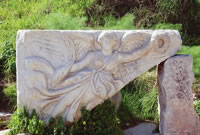 |
|
| Ephesus was in great prosperity during the times of Alexander the Great Until the arrival of Alexander the Great, Ephesus was consisted of two governing systems, democratic and oligarchic. But the oligarchic system was violated with the coming of a new ruler, and a rebellion existed in Ephesus. The Temple of Artemision was fired and destroyed by the supporters of oligarchy in 356BC. |
|
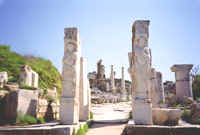 |
|
As the temple became unusable, Alexander the Great proposed for repairing. But the Ephesians delicately refused for the reason that "A God can not built a temple for a God". An Ephesian architect, Dinocrates restored the Temple of Artemision. After the death of Alexander the Great, Ephesus was ruled by the general of him, Lysimakhos, in 287 BC. Lysimakhos decided to change the prior location of Ephesus to further west, due to the |
|
| destruction of the port by the alluviums, and the inhabitants were forced to settle in the new place named "Arsinoeina", the name of Lysimakhos' wife. The city was surrounded by wide stone walls in 10 meters height and 9 meters length. With the death of Lysimakhos, Ephesians destroyed most of the city walls. And, "Arsinoeina" was changed into "Ephesus" again, to be forgotten eternally. |
|
| Ephesus was controlled by the Romans in 190 BC. The city was given to the Bergamian kings for a time. With the death of King Attalos 3 in 133BC, the city was re-ruled by the Romans. Ephesus reached to its height and was notorious for its wealth and luxury between 1-4 AD., especially during the reign of Augustus. During the period, the population of Ephesus increased to 225 000, and the city became the capital of the new Asia. |
|
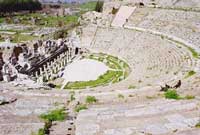 |
|
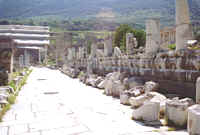 |
|
By cleaning the river Caystros from the alluviums, the great trade port of Ephesus, a gateway to foreign countries, enriched the prosperity of the city and continued to thrive with commerce and culture. The city was constructed, adding new models to the former magnificence of Ephesus. "Celcius Library" clearly exemplifies the perfecta of the era, with the delicate details of the construction. |
|
| Ephesus has played significant roles during the date, in the early Christianity, as well. The prestige of Ephesus increased with the arrival of St. Paul, for spreading the Christianity to the Ephesians worshipping to Artemision. St. Paul and the disciplines of Christianity were strictly refused by Ephesians, elderly. With the long tiring struggles of St. Paul, Christianity was accepted by the most of the population around Ephesus. |
|
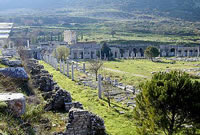 |
|
| St. Paul had also sent one of his most famous letters to the church in Ephesus. Additionally, St. John and Virgin Mary visited Ephesus and Virgin Mary settled down the Mount Bulbul, located close to Ephesus, around the years of 431 AD. |
|
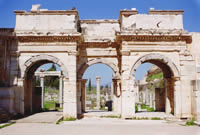 |
|
Ephesus became a state of Seljukian in the year of 1090, for a time was held by Byzantine. In 1307 Seljukians controlled the city again. However, years later, the River Caystros was silted up, leaving the site far inland.
Therefore, the city of Ephesus has lost its significance, due to the development of the ports of Izmir and Kusadasi in sea-trade. |
|
|
 |
|
|
|